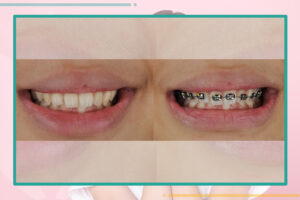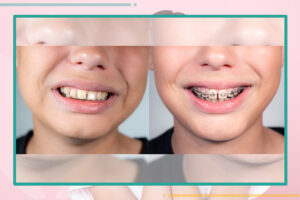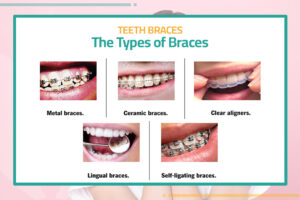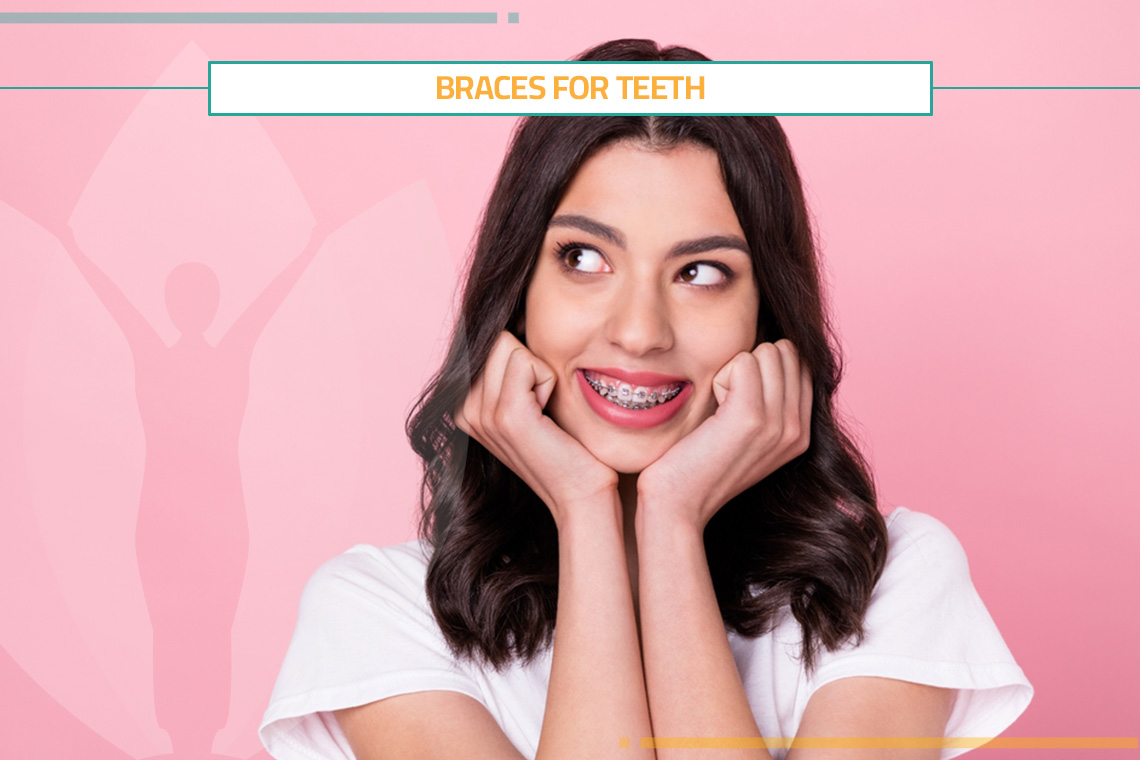Braces for Teeth
Braces for teeth straighten teeth and address a variety of orthodontic problems, including:
– Crooked teeth.
– Crowded teeth.
– Missing teeth.
– Problems with the way your teeth fit together are known as malocclusion.
– Braces are frequently worn by youngsters and teenagers, but they are also frequently used by adults. Actually, adults over the age of 18 make up 20% of all orthodontic patients in the US.
Orthodontists typically apply braces. However, some general dentists also provide them.

FAQ`s about Affordable Teeth Straightening
-
How Do Brackets Function?
Over time, braces move your teeth into their correct places by applying gentle, continuous pressure. The kind of braces you select will determine how exactly this occurs.
2. What Types of Braces Are There?
Braces come in a number of varieties. A number of variables, such as the nature of your problem, the severity of your condition, and your individual preferences, will determine which type is ideal for you.
3. When Is the Greatest Age to Get Braces?
It’s never too late to have orthodontic treatment. Having said that, the ideal age range for braces is often 9 to 14. Because they are still growing, your jaws and face bones are more pliable at this stage. Although it may take a bit longer to get the desired results, adult braces are equally effective.
4. How can braces be fitted?
Many kids don’t need braces, but those who do need their dentist to recommend them to an orthodontist. Only licensed specialists are permitted by law to identify themselves as specialist orthodontists.
It’s possible that other dentists have completed further training to provide orthodontic therapy.
Under their supervision, some orthodontists collaborate with orthodontic therapists to modify braces.
The best products for hair care
5. Are Braces for Teeth Successful?
Teeth straighteners is generally successful, but it requires consistent follow-up. After treatment, a retainer is worn to prevent teeth from moving back to their pre-treatment position. There are various types of retainers available, either removable or fixed. Braces can trap food and build plaque, so regular cleaning is crucial. Eating a healthy diet, such as avoiding sugary foods and drinks, is also important. It’s essential to continue seeing your regular dentist for orthodontic treatment.
6. How Long Will I Should to Wear Braces?
Braces typically last about 2 years, but this can vary depending on the severity of the problem, jaw space, oral health, and the follower’s adherence to orthodontist’s instructions. After braces are removed, a retainer is required to maintain the newly positioned teeth. The retainer should be worn all the time for the first 4 to 6 months, then only in bed. The duration of wearing the retainer depends on the orthodontist’s recommendation, and it may be necessary for the rest of your life to maintain proper alignment. It is essential to follow your orthodontist’s instructions closely to avoid tooth shifts.
7. What Are the Side Effects of Braces?
Braces have a few minor, anticipated adverse effects, such as:
– Momentary soreness (typically experienced on the first day and whenever your braces are tightened by your dentist).
– Irritation of the inner cheeks, lips, or tongue.
– Jaw ache.
– Eating difficulties, particularly following a tightness.
– Over-the-counter (OTC) pain medicines can help you manage the majority of these side effects. – To lessen oral irritation, you can also get dental wax for braces from your neighborhood pharmacy. Just apply some wax to any wire or brackets that feel scratchy.
8. How long should I wear braces?
Orthodontics typically last about two years, but this can vary depending on the severity of the problem, the space in your jaw, your oral health, and your adherence to your orthodontist’s instructions. After your braces are removed, a retainer is needed to hold the newly placed teeth in place. Moreover, the retainer should be worn at all times for the first 4 to 6 months, and then only in bed. The length of time you wear your retainer depends on your orthodontist’s recommendation, and it may be necessary for the rest of your life to maintain proper alignment. It is important to follow your orthodontist’s instructions closely to avoid teeth shifting.
9. What are the side effects of braces?
Braces have some minor side effects to expect, such as:
- Temporary pain (usually occurs on the first day and whenever your dentist tightens your braces).
- Irritation of the inner cheeks, lips, or tongue.
- Jaw pain.
- Difficulty eating, especially after the teeth are tightened.
- Over-the-counter pain relievers can help you manage most of these side effects.
- To reduce mouth irritation, you can also get orthodontic dental wax from your local pharmacy.
- Simply apply some wax to any wire or bracket that feels itchy.

Best Way to Straighten Teeth at Natural Beauty Turkey
What to anticipate:
First Consultation: Your oral health history, any issues, and your general oral hygiene regimen will all be covered by our dental professionals.
Examination:
The most up-to-date diagnostic equipment will be used to perform a thorough examination of your mouth, teeth, and gums.
We look for:
– Tooth decay or cavities
– Gum disease (periodontia or gingivitis)
– Oral cancer symptoms
– Problems with bite and tooth alignment
– General dental hygiene
10 Important Tips to Reduce Flat Tummy
X-rays:
To get a closer look, we will take digital X-rays of your teeth to find any hidden problems such infections, bone loss, or impacted teeth.
Professional Cleaning:
Frequent professional cleanings aid in the removal of tartar and plaque accumulation that is not possible with routine brushing and flossing.
Personalized Care Plan:
Whether it involves regular maintenance, additional treatments, or cosmetic upgrades, we will create a customized treatment plan based on the results of your examination.
Orthodontic Treatment and Braces
• Orthodontic treatment aims to improve teeth and gum health.
• Treatment involves straightening teeth, closing gaps, and correcting bite.
• Healthy teeth and gums are required for brace fitting.
• Regular cleaning of teeth and brace is essential to prevent tooth decay or gum disease.
• Treatment typically lasts 12 months to 2.5 years, with orthodontist visits every 4 to 10 weeks.

Traditional Metal Braces
Conventional braces use brackets and wires, typically composed of metal, that are fastened to the teeth and enable them to be moved as needed. A more recent addition to conventional braces are heat-activated archwires. These make use of body heat in the mouth to facilitate faster and less painful tooth movement than was previously feasible.
One of the most popular styles of braces used today, these braces are usually the least expensive alternative despite being highly effective. They are the most noticeable kind, though, and some people could be self-conscious about the way they look. Although they are still visible, their appearance can be somewhat improved by covering the braces with bands of various colors.
Ceramic Braces
In terms of size and design, ceramic braces are fairly comparable to typical metal braces. However, because they are made of a ceramic material that complements the natural color of the teeth, the braces are less obvious.
This type is equally as successful as regular braces at moving teeth into the appropriate positions, but because of their color, they are far less obvious, making them a better option for some people. Additionally, they are usually more costly than standard braces, though, and if not properly maintained, they could get discolored.
Key Facts about Teeth Straighteners
- Your teeth can be straightened with the use of dental braces and retainers.
- If you wish to improve your smile, have jaw function issues, or need to adjust your bite, your dentist or orthodontist may suggest braces.
- You can choose from a variety of dental brace choices by consulting with your dentist or orthodontist.
- Typically, orthodontic treatment is completed throughout adolescence.
- It typically takes one to three years for these appliances to straighten your teeth.





